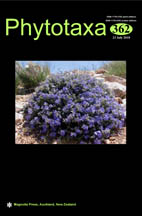Abstract
Olifantiella Riaux-Gobin & Compѐre (2009: 179) is a biraphid diatom genus established within the last ten years. All the taxa reported in the genus Olifantiella share a very small size (mostly 5–17 μm long and 1.2–4 μm wide) (Riaux-Gobin & Al-Handal 2012, Riaux-Gobin 2015, Van de Vijver et al. 2016). As such, they are usually difficult to observe and identify under a light microscope (LM). However, electron microscopy (EM) has aided in the understanding of many morphological features. Externally, the striae are composed of macroareolae. An isolated process opening is often positioned at midvalve. This is quite different from the stigma openings of Gomphonema Ehrenberg (1832: 87) taxa (Kociolek & Kingston 1999, Kulikovskiy et al. 2015, Stancheva et al. 2016, Zhang et al. 2016). It is connected to an internal process named buciniportula. This tubular structure is unique in Olifantiella. It is more complex than rimoportulae in some araphid genera, such as Synedra Ehrenberg (1830: 60) (Williams & Round 1986) and Falcula Voigt (1960: 85) (Takano 1983, Donadel & Torgan 2016).

